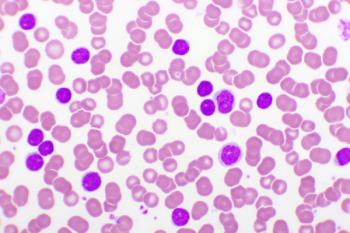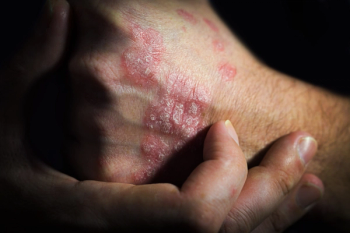
- July 2025
- Volume 31
- Issue Spec. No. 8
- Pages: SP498-SP499
In VERIFY, Rusfertide Spares Most Patients With PV a Phlebotomy for 32 Weeks, Improves QOL
Key Takeaways
- Rusfertide significantly reduced phlebotomy needs in PV patients, with 76.9% achieving clinical response versus 32.9% in the placebo group.
- The therapy maintained hematocrit levels below 45% in 62.6% of patients, compared to 14.4% in the placebo group.
Adding rusfertide to standard of care more than doubled the share of patients with polycythemia vera (PV) who did not meet criteria for a phlebotomy, according to data from the VERIFY trial.
Patients with polycythemia vera (PV) may soon be spared repeat phlebotomies, following results that show a new therapy prevented the buildup of excess blood cells and eased painful symptoms.
Adding rusfertide to standard of care more than doubled the share of patients with PV who did not meet criteria for a phlebotomy, according to data from the VERIFY trial (NCT05210790), presented during the plenary session of the
Andrew T. Kuykendall, MD, lead investigator for VERIFY and associate member, Department of Hematology, Moffitt Cancer Center, shared findings from the first part of the trial, which evaluated rusfertide’s efficacy through week 32. An open-label long-term phase follows for weeks 32 to 52.
“Polycythemia vera represents a unique situation, where you have overproduction of red blood cells in the setting of systemic iron deficiency,” Kuykendall explained Sunday. In PV, he said, iron flows freely to the bone marrow, causing a ramp up of red cell production while depriving other tissues and organs of their needed iron supply. Thus, patients with PV experience both the fatigue caused by iron deficiency and the fallout of too many red blood cells, which cause bone pain and raise the risk of stroke, deep vein thrombosis, or pulmonary embolism.
Rusfertide, a hepcidin mimetic peptide, is being developed by Protagonist Therapeutics and by Takeda Oncology. The therapy behaves like the natural hormone hepcidin to regulate iron levels in the blood. This helps patients maintain a steady hematocrit level, which is the percentage of red blood cells in the body’s overall supply—a healthy level is at or below 45%.
“When you control the iron in an optimal way, you are able to control the production of red blood cells. Typically, when hepcidin goes down, iron exchange into the bone marrow goes up,” explained Ramon Tiu, MD, head and vice president, Hematologic Malignancies and Cell Therapy Development for Takeda Oncology. In PV, the dysregulation of iron in the blood supply causes congestion of red blood cells, leading to thromboembolic illness, Tiu said in an interview.
The American Journal of Managed Care® (AJMC®) asked Tiu if the mechanism of rusfertide in PV was akin to the use of insulin and new technologies to manage blood glucose levels in patients with diabetes; Tiu agreed this was a good comparison, in part because both treatments seek to keep patients in a consistent range. As with glucose in diabetes, large fluctuations in hematocrit levels take a toll on the body and account for the health problems patients experience over time.
VERIFY involved 293 patients, randomized 1:1 to receive rusfertide (147 patents) or placebo (146 patients). Of the group, 73% were male, with a median 57 years of age (range, 27-86). In the 2 groups, 83 patients taking rusfertide (56.5%) and 81 taking placebo (55.5%) also received cytoreductive therapy.
A weekly dose of rusfertide, which patients give themselves through subcutaneous injection, brought remarkable effects, Kuykendall said. Results were as follows:
- The study’s primary efficacy end point was the share of patients achieving a clinical response and the absence of phlebotomies from weeks 20 to 32. Results showed 76.9% of the rusfertide group achieved this response, compared with 32.9% of the placebo group (P = .0001).
- Only 27% of patients taking rusfertide required phlebotomies in weeks 0 to 32, compared with 78% who received placebo plus standard of care.
- The mean number of phlebotomies per patient was 0.5 for the rusfertide group, compared with 1.8 in the placebo group. In the rusfertide group, this mean number was reduced across subgroups, including risk status and use of concurrent cytoreductive therapy, vs the placebo arm.
- 62.6% of patients in the rusfertide group maintained hematocrit levels below 45%, compared with 14.4% in the placebo group (P < .0001).
- Patients taking rusfertide showed statistically significant improvements in quality of life scores, across 2 different measures, the PROMIS Fatigue score and the Myelofibrosis Symptom Assessment Form (MFSAF) Total Symptom Score.
PV is among a group of blood cancers known as
Adverse events (AEs) were generally low grade; these included localized injection site reactions (55.9%), anemia (15.9%), and fatigue (15.2%). Serious AEs occurred in 3.4% of the rusfertide arm and 4.8% of the placebo arm; however, none were considered related to rusfertide. Cancer was reported in 1 patient in the rusfertide arm (0.7%) and in 7 patients in the placebo arm (4.8%).
Both Kuykendall, in his presentation, and Tiu, in the interview, emphasized the improvements in fatigue and symptoms among patients taking rusfertide.
“The vast majority of these patients suffer from very significant fatigue. They suffer from significant bone pains,” Tiu said. The improvements seen in both the PROMIS and the MFSAF scores are “unprecedented,” he said.
“This matters a lot,” Tiu said. “These patients suffer from these symptoms, and it's clear that when you treat them with rusfertide, there is an improvement in those symptoms.”
Kuykendall said evaluating symptom improvement is somewhat challenging because patients are starting at different baselines, and it’s an area that will require more follow-up. “We plan to explore this further in upcoming analysis,” he said. “Given this is a chronic malignancy, we are very focused on more long-term treatment outcomes.”
Reference
Kuykendall AT, Pemmaraju N, Pettit KM, et al. Results from VERIFY, a phase 3, double-blind, placebo (PBO)-controlled study of rusfertide for treatment of polycythemia vera (PV). J Clin Oncol. 2025;43(suppl 17):Abstract LBA3. doi:10.1200/JCO.2025.43.17_suppl.LBA3
Articles in this issue
Newsletter
Stay ahead of policy, cost, and value—subscribe to AJMC for expert insights at the intersection of clinical care and health economics.









































